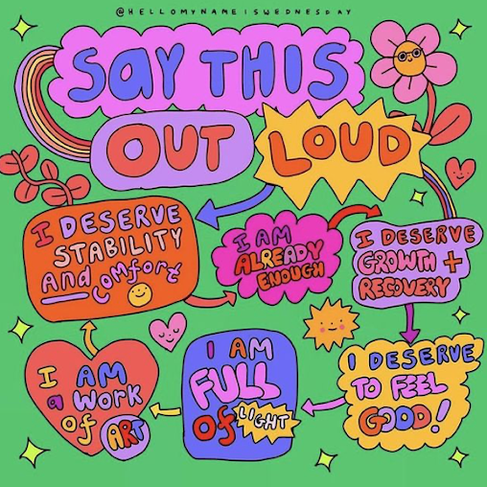Flags, Advocacy, & Allyship
- dandi50
- Jun 3, 2022
- 8 min read
Art by Casey Jeanne Thompson - PCSD 2021
WELCOME
June is Pride Month, a time dedicated to promoting and celebrating LGTBQIA+ people as a group (see below for a guide on these letters!). Pride, as opposed to shame and social stigma, is the predominant outlook that bolsters most LGTBQIA+ rights movements.
Over the past 50 years, pride events, marches and demonstrations have evolved considerably. In nations where LGBTQ+ people are protected and acceptance is high, many pride events have grown in scale, welcoming millions of visitors to their celebrations.
Major cities like New York, São Paulo and Madrid host some of the largest events in the world with crowds of up to 5 million people (according to the The International LGBTQ+ Travel Association).
SPOTLIGHT : Interview with Jeannie Gainsburg : Savvy Ally Action
In 2003, Jeannie Gainsburg looked up the word gay in the phone book, found the local LGBTQ+ center in Rochester, NY, the Out Alliance (formerly the Gay Alliance), and called to ask if she could volunteer. After 2 years of volunteer work, Jeannie was hired by the agency as the Education and Outreach Coordinator.
In 2013, she was promoted to Education Director, a position she held for an additional 5 years. Jeannie has personally facilitated or co-facilitated more than 500 trainings and workshops in more than 20 different states at corporations, colleges, government agencies, K-12 schools, hospitals, faith communities, and more. During her time at the Out Alliance, Jeannie transformed the education program from offering 20 workshops annually to 250.
In 2018, Jeannie founded Savvy Ally Action, a small business that offers fun, accessible, and encouraging workshops, videos, and handouts on how to be an ally to the LGBTQ+ communities. In 2020 her book, The Savvy Ally: A Guide for Becoming a Skilled LGBTQ+ Advocate, was published by Rowman & Littlefield.
Downloadable Teaching Resources
Find more resources and support at SavvyAllyAction.com!
OUR PROGRAM - CELEBRATING PRIDE
Week 1: What is the LGBTQIA+ community and what does PRIDE mean?
Week 3: Flags, Advocacy, & Allyship!
Flags, Advocacy, & Allyship!
Flags: Different Flags to Represent and Acknowledge Identity Groups.
There are many different groups within the LGBTQIA+ community and each group has its own flag, some have several and each one has its own history.
There are so many different sexualities and groups in this community it is very difficult to cover all of them since there are many, but here are some of the more common ones.

Gay → person who is emotionally, romantically, or sexually attracted to members of the same gender.

*This flag is one that has been created to include people of color.

Lesbian → Women who are emotionally, romantically or sexually attracted to other women.

Bisexual → A person who is emotionally, sexually or romantically attracted to more than one gender.

Pansexual → A person who is attracted to people regardless of gender.

Polysexual → A person who is attracted to multiple genders but not all genders.

Asexual → Someone who lacks sexual attraction or desire for other people.

Transgender → A person whose gender doesn’t match the gender they were assigned at birth.

Non-Binary → Someone whose gender falls outside of the strict male/female binary.

Intersex → Individuals who have various physical differences that fall outside of the male/female binary

Genderfluid → Someone whose gender identity/gender expression is fluid and changes over time.

Agender → Someone who doesn’t have a gender, is sometimes described as having a “lack of gender.”
Additional Resources:
Education
Although we want to CELEBRATE this month, we also want to educate: One of our contributors reports Advocating as a young trans person, is necessary and frequent. The more the community knows, the more we can uplift, and not burden our diverse and beautiful fellow people, and embrace them in their full valid humanity.
LGBTQIA+ Community Demographics
The following LGBT Demographic Data Interactive. (January 2019). Los Angeles, CA: The Williams Institute, UCLA School of Law asks respondents, “Do you, personally, identify as lesbian, gay, bisexual, or transgender?”. We include all individuals in the data that self-identified as LGBT (both single and coupled). That is who is presented on these maps and charts. Thus, these data give a peek at the characteristics of the LGBT community living in the United States as a whole. (click on the map to see more detailed demographics by age and race).
School Climate Concerns for LGBTQ+ Children
In 2019 GLSEN reports that LGTBQIA+ people are more than four times more likely than non-LGTBQIA+ people to be victims of violent crime. LGBT youth seriously contemplate suicide at almost three times the rate of heterosexual youth. Additionally, LGBTQAI+ youth are subjected to frequent microaggressions- invalidations of their identities. It's important to be aware of Misgendering, and other unintentional, but harmful acts.

Read more about school climate of LGBTQ students in the GLSEN 2019 New York State Snapshot.

If you are a young person in crisis, feeling suicidal, or in need of a safe and judgment-free place to talk, call the TrevorLifeline now at 1-866-488-7386.
To get information about ensuring LGBTQ students are able to learn and grow in a school environment free from bullying and harassment, check out the GLSEN website.
Learn more about the experience of LGTBQ youth by reading the GLSEN National School Climate report from 2019 or the Trevor Project’s National Survey on LGBTQ Youth Mental Health 2021. To learn more about and support Trans Youth, check out Trans Student Educational Resources.
Teaching LGBTQ and Gender Inclusivity

The Human Rights Campaign has resources, including "Welcoming Schools". Welcoming Schools offers comprehensive, teacher-friendly lesson plans to help educators do the important work of building welcoming, affirming LGBTQ and gender inclusive schools that create a sense of belonging for all students, families and staff.
Welcoming Schools offers lesson plans under four umbrella topics: gender, family, LGBTQ inclusive, and bullying. Together, these lesson plans help develop safe and welcoming classrooms and schools.
Intersectionality
The LGBTQIA+ community is intended to be welcoming to all but even so there are some instances of racism within the community. It's important to discuss intersectionality, when we talk about identity groups.
Although we may focus on one group/identity, we want to acknowledge both individual and group experiences, that can lead to instances of greater marginalization/and oppression, or privilege.
Queer people of color have been leaders in human rights movements again and again, from the first Pride with Marsha P Johnson & Sylvia Rivera to the Black Lives Matter Movement with Alicia Garza, Patrisse Cullors and Opal Tometi (two of whom identify as queer).
General Representation in Media
The general representation of the LGBTQIA+ community in media is skewed towards gay white cisgendered men (think Jack from Will and Grace), and this isn’t an accurate representation of the queer community.
There are many races included in the queer community and they make a large portion. 42% of the LGBTQIA+ community is a racial minority
This also is an issue when it comes to the other groups in the LGBTQIA+ community, many times there isn’t representation of those who are non-binary or gender nonconforming.
Commercialization of Pride Month
One of the times of the year where there is a lot of LGBTQIA+ representation in commercial as well as media is Pride Month. Though this is a good thing to be represented, many companies use their time to sell inclusive products which they don’t sell year round and are targeted specifically towards those that are a part of the LGBTQIA+ community. During this time of the year many companies also use models that are LGBTQIA+ in their marketing, but only for this month. This can be considered tokenism.
There should be this representation year round whether it is advertisements or clothing, those who are a part of the queer community don’t just disappear after June. This lack of year round representation when it comes to companies can be seen as an exploitation of the LGBTQIA+ community as well as just a way to make more money. It can also be creating this fake guise of acceptance that goes away one the clock hits July 1st.
Solidarity and Allyship
Whether you are a part of a group, or not, we are united together hoping to see each other in full humanity. For that reason, we feel it’s important to give resources for children and adults on being an ally, and an upstander- the ways you can stand up for those who aren't being treated well.
Even from within the National PTA, the messaging is clear, allyship is critical to increase LGBTQIA+ Acceptance and our children's wellbeing.
Find out more about how your PTA is the right space to promote allyship in your schools.
Responding as a Bystander
One way to practice allyship is responding and supporting people from a group. What’s worse than being targeted with harassment because of your sex, religion, gender, or orientation? Being targeted while surrounded by bystanders who see what is happening, but then do nothing.
It doesn’t have to be that way. At this moment in history, we are witnessing a spike in disrespect, harassment, and hate violence. As bystanders, we need to be especially vigilant and aware of what disrespect, harassment, and hate violence look like in order to be able to stand up and intervene at a time when people need it most.

You can make a choice to actively and visibly take a stand against harassment. The Five D’s are different methods you can use to support someone who’s being harassed, emphasize that harassment is not okay, and demonstrate to people in your life that they too have the power to make our communities and workplaces safer. See Hollaback LGBTQ Harassment Guide for more information.
CELEBRATE PRIDE - YOUR WAY….
PRIDE is a time for people outside of the community to consider how they can better support LGTBQAI+ children and adults. It is also an essential time for people within the community to celebrate and show their strength and beauty.
We conclude this week with a short video: From the show Blues Clues- Pride is certainly for all. And for all ages. Hope this brings you joy if not happy tears as it did mine- feeling my family was both seen and celebrated and valued.
Whether you Walk, Talk, Watch, Read, or Chalk Pride...

Insta Pride, Ride Pride (Seabreeze Pride day 7/24) or Just Think Pride...
Pittsford PTSA wishes you a happy PRIDE this month, and all months.
YOU make PITTSFORD PROUD
2021 Community Pride Events!
The Pittsford Central PTSA DEI Committee invites you to join the community on June 27th for a Pittsford PRIDE event. Co-sponsored by the Safe ZOne initiative and PittsFORWARD. All are welcome for this youth and community focused event Sunday June 27th from 3 - 5 p.m.
Whether you identify as part of the LGBTQ+ community or an ally, Trillium Health is proud to stand with you! You are our patients, our employees, and our neighbors, and providing an inclusive, welcoming space has been the cornerstone of our organization for more than 30 years. That will never change. We hope during the month of June – and all year long – you will celebrate your true colors with pride. Trillium Health is proud to promote these Pride Month Events!
“We don't have to engage in grand, heroic actions to participate in the process of change. Small acts, when multiplied by millions of people can transform the world” -Howard Zinn
The Pittsford Central PTSA DEI Committee seeks to celebrate ALL residents and truly value diversity and inclusion. We emphasize that our differences truly make us better. We know that it is essential to create welcoming schools and classrooms where differences in language, culture, race, ethnicity, sexual orientation, gender, unique abilities, etc., are viewed as assets rather than deficits. An awareness and acceptance of these differences are foundational to the success of all students.
As a small group of volunteers, we acknowledge we may be incomplete in our coverage of this topic. For that reason - we welcome you to contact us with suggestions and additions regarding any of this material, you may reach the Diversity, Equity and Inclusion Committee via our feedback form below. We can add more to our posts throughout the month and plan to build on this material in future years.
Indigenous Land Acknowledgement
We acknowledge the Seneca people as the traditional custodians of the land that we are on and for their enduring presence. We would also like to pay respects to Elders past and present of the Hodinöhsö:ni' Confederacy, and we extend that respect to any other indigenous people who are present with us today. We make this acknowledgment as a first step in fulfilling our responsibility to critically look at colonial histories and their present-day implications as we pay respect to the keepers of the land, and the land itself. We are aware that acknowledgment is not reparation, and land acknowledgment without active steps towards education, support of the Seneca Nation, and sincere efforts to undo colonial legacies means very little.




































Comments